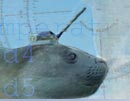 |
||
| |
||
| |
||
| |
||
| |
||
| |
||
| |
||
| |
||

 |
Results: Oceanographic Data |
 |
|||||||
Oceanographic Data The SEaOS oceanographic data is freely available here, and soon from the British Oceanographic Data Centre. |
|||||||||
Across the world scientists and non-scientists alike are very concerned with how global warming of the planet may change our climate. Thermal energy from the sun is stored mainly in the top layer of the world’s oceans, which contain more heat than the entire atmosphere. The movement of this vast amount of stored heat, sometimes called the "Global Conveyor", significantly affects the global climate. Surrounding the Antarctic Continent and linking all of the world's oceans, the Southern Ocean forms a key part of the “Global Conveyor”.
|
|||||||||
|
|||||||||
Previously to gather eight similar concurrent records of salinity and temperature across the Indian Ocean sector of the Southern Ocean would have required the simultaneous use of eight research vessels, an expedition of prohibitively high cost. Further, in addition to providing these tracks, the seals remained in or near the ice collecting data throughout the rest of the Antarctic winter. This would not be a practical option for most ship-borne expeditions. |
|||||||||
The diagram below was made using two profiles made by a seal called Bernt travelling between South Georgia and Tristan da Cunha. He was studied while he made two journeys six months apart, both along a similar track. The fact that seals tend to follow similar routes at specific times helps us to collect data in a predictable manner, in order to gain information about dynamic phenomena such as ocean fronts.
The profiles are shown with an impression of the locations of ocean fronts indicated. Fronts are regions with strong currents (jets) within the Antarctic Circumpolar Current which flows eastward around Antarctica. Fronts are also regions where there are strong horizontal gradients in ocean properties such as temperature, and salinity.
|
|||||||||
![]()
Home - Introduction - Natural History - Conservation - Technology - Results - Collaborators - Access
Sea Mammal Research Unit - School of Biology - University of St Andrews




